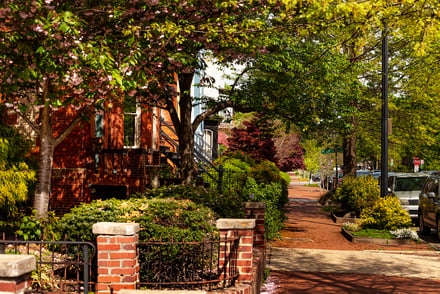Water is an insidious enemy for homeowners. It can find the smallest entry point and travel throughout your home’s interior to cause significant damage. Often, when the damage becomes visible, it is not a reliable indicator of a leak’s source location. If you’ve ever asked, “Where’s that leak coming from?” – you are not alone.
Owners of historic brick homes can face even more significant challenges. Let’s talk about some possible leak locations. We'll start at the top.
Roof
Roof leaks are often difficult to locate, primarily because the roof is not accessed easily. Roof leaks can allow water to compromise insulation and structural components, endangering your safety and your home’s structural integrity. A roof leak goes undetected too often until dampness causes wet spots and discoloration in ceilings, walls, or other areas.
Water follows the path of least resistance, so a leak in one area can cause extensive damage far away from the point of entry. If you suspect a roof leak or discover any evidence, seek a roofing professional for an inspection and recommendations.
Windows and Doors
Windows and doors can become worn with age. Seals and mountings can shrink or become brittle and wear away, allowing water to enter walls, floors, and other areas. Winds, heavy rain, snow, and prolonged exposure can lead to extensive damage, much of which can be out of sight. By the time signs of water damage become noticeable, you could have weakened structural components, masonry, and interior surfaces.
Failing Mortar/Masonry
Older brick homes were constructed with brick and mortar manufactured in their era. While these historic brick homes (18th, 19th, and early 20th century) were built to last, time and exposure to weather over many decades ultimately takes its toll. Even brick and mortar deteriorate over many years. Mortar can flake away from between bricks, allowing moisture to enter between the joints and penetrate interior walls. As that moisture accumulates and travels, you could have vast problems and damage that far exceed the small outer spot needing repair.
"A common but unfortunate misconception is that replacing old mortar with something more rigid and durable, like Portland Cement, will fortify an old brick facade. Sadly, this method will inevitably lead to spalling damage..."
Moreover, if a contractor or DIYer inexperienced with older historic brick homes has performed exterior repairs, they may have used a newer type of mortar. A common but unfortunate misconception is that replacing old mortar with something more rigid and durable, like Portland Cement, will fortify an old brick facade. Sadly, this method will inevitably lead to spalling damage as the newer materials fail to expand and contract as needed, putting unbearable stress on the old facade. This new material does not allow sufficient evaporation to let the wall breathe, trapping moisture within the wall leading to brick and interior wall damage.
Tuckpointing is the method of replacing deteriorating or faulty mortar with the historically accurate mortar mix to match the age of the bricks. Proper evaporation outside will prevent moisture intrusion and damage from happening inside. If you have an older, historic brick home, check with us at Renaissance Development for an inspection and period-sensitive repairs to extend the life of your home.
Foundation/Drainage Issues
Some older homes will develop foundation and drainage issues as they shift or the ground shifts over time. Without proper drainage to channel water away from your home, it can enter basements, crawlspaces, and even penetrate your home’s foundation. Renaissance Development can perform a site inspection to determine the source of your water intrusion. If masonry issues are not the cause of your water problem, we can recommend other solutions and may be able to guide you to the appropriate resources.
Call Renaissance Development in Washington DC at 202-547-2345 or complete our online contact form to inquire about locating the source and designing solutions for water leaks in your historic brick home.
11/6/20 1:51 PM


